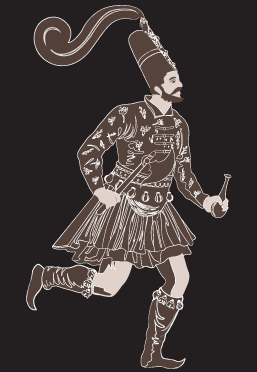PEYK
PEYK

During the Ottoman era, the sultan's couriers were called "peyk" and these young postmen were a special military class that were trained from early ages to become messengers of the sultan's personal orders. At first only serving as news carriers, the peyk couriers were later given the privilege of standing beside the sultan at ceremonies in a more ostentatious role to reflect the resplendence of the era. The quarters of the peyk couriers were called Peykhane. Today, the word Peykhane refers to the street where these quarters were originally located. This street is named Peykhane Street, which happens to be the street on which the Peyk Hotel stands.
The best of the peyk were called "müjdeji" or "bearer of good tidings." These couriers would run like the wind, clad in distinctive costume, to announce to the sultan the return of the processions of pilgrims from the Haj. The apparel of the peyk couriers varied according to their ranks. Their headgear, called "üsküf," was decorated with solid gold, silver and metal, topped by bird feathers. Their knee-length caftans had belts or cummerbunds on which would hang a dagger, and in their left hands they would carry a pouch full of hard candy or sugared almonds. The peyk would carry a small axe or "taber" in the right hands and as they ran through the crowds, the small bells that were hidden in the folds of their garment would ring to alert people to give them way.
The peyk would run with porous spheres in their mouths to regulate their breathing. Until the sixteenth century, they would run barefoot but later their costumes also began to include thin pieces of leather that would be sewn onto their socks. The miracle men of the Ottomans, the peyk couriers displayed unprecedented endurance and quickly became one of the most original figures of the Ottoman period.
The best of the peyk were called "müjdeji" or "bearer of good tidings." These couriers would run like the wind, clad in distinctive costume, to announce to the sultan the return of the processions of pilgrims from the Haj. The apparel of the peyk couriers varied according to their ranks. Their headgear, called "üsküf," was decorated with solid gold, silver and metal, topped by bird feathers. Their knee-length caftans had belts or cummerbunds on which would hang a dagger, and in their left hands they would carry a pouch full of hard candy or sugared almonds. The peyk would carry a small axe or "taber" in the right hands and as they ran through the crowds, the small bells that were hidden in the folds of their garment would ring to alert people to give them way.
The peyk would run with porous spheres in their mouths to regulate their breathing. Until the sixteenth century, they would run barefoot but later their costumes also began to include thin pieces of leather that would be sewn onto their socks. The miracle men of the Ottomans, the peyk couriers displayed unprecedented endurance and quickly became one of the most original figures of the Ottoman period.
